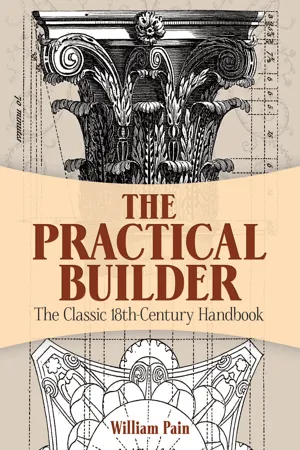
This is a test
- 96 pages
- English
- ePUB (mobile friendly)
- Available on iOS & Android
eBook - ePub
Book details
Book preview
Table of contents
Citations
About This Book
This 1774 guidebook for English carpenters was one of the earliest `do-it-yourself` manuals ever published. The builders' manuals and pattern books of the eighteenth and nineteenth centuries offered carpenters and other construction workers important resources for designs and techniques. Those unable to afford an architect's services could feel confident in the good taste of their residence by selecting designs from a pattern book. Employing elementary arithmetic and geometry, the guide's annotated and meticulously rendered engravings depict cross-sections of chimney-pieces, ceilings, cornices, and other architectural details.
William Pain's manual was one of the earliest such works published in the United States. Printed in Philadelphia in 1797, it helped standardize key aspects of Federal architecture and served as a model for construction at George Washington's Mount Vernon home. Reprinted from an original 1774 edition, this is the only available version of a splendid reference for architectural historians and those with an interest in classical architecture.
William Pain's manual was one of the earliest such works published in the United States. Printed in Philadelphia in 1797, it helped standardize key aspects of Federal architecture and served as a model for construction at George Washington's Mount Vernon home. Reprinted from an original 1774 edition, this is the only available version of a splendid reference for architectural historians and those with an interest in classical architecture.
Frequently asked questions
At the moment all of our mobile-responsive ePub books are available to download via the app. Most of our PDFs are also available to download and we're working on making the final remaining ones downloadable now. Learn more here.
Both plans give you full access to the library and all of Perlego’s features. The only differences are the price and subscription period: With the annual plan you’ll save around 30% compared to 12 months on the monthly plan.
We are an online textbook subscription service, where you can get access to an entire online library for less than the price of a single book per month. With over 1 million books across 1000+ topics, we’ve got you covered! Learn more here.
Look out for the read-aloud symbol on your next book to see if you can listen to it. The read-aloud tool reads text aloud for you, highlighting the text as it is being read. You can pause it, speed it up and slow it down. Learn more here.
Yes, you can access The Practical Builder by William Pain in PDF and/or ePUB format, as well as other popular books in Architecture & History of Architecture. We have over one million books available in our catalogue for you to explore.
Information
Topic
ArchitectureSubtopic
History of ArchitectureTo face PLATE I.
Figure A and B are ribb’d NICHES for Plaistering.
THE Plan a is a Semi-Elipsis on the transverse Diameter, which is drawn with a Tramel as represented in the Plan, which is to be made with a Grove at Right Angles as in the Figure; two Pieces to be morticed to slip on the Rod, and one fixed at tile End for a Pencil, &c. fix one of the Pieces equal to half the Conjugate Diameter, and the other to half the Transverse Diameter, and moving the Rod with the Pins in the Groves, the Pencil will describe the Semi-Elipsis.
To draw the Elipsis c to any given Length and Breadth, take half the Conjugate Diameter a b and fet it on the Transverse Diameter d c divide c a into three equal Parts, and make c e equal to one of those Parts, and with the Radius e f bisect g g. So the Points e f and g g are the Centres for drawing the Elipsis to any Length and Breadth.
To draw the Elipsis d with a Line, take half the Transverse Diameter b a and set it from c on the Conjugate Diameter to d on the Transverse Diameter, and to e on ditto, then e d are the Points to be fixed for the Line to go round, which will describe the Elipsis with the Point f.
To glue the Head of a Nich as Figure e, cut the Arch Part of the Board or Stave to the Thickness of a Veneer, and bend it on a Templet, and back it to the Curve, it may be jointed the same as a Column, &c.
To describe a Polygon to a given Side from five to eight Sides, make a Radius of the given Side for the Pentagon, divide the Arch into five Parts, turn one down on the Line which is the Centre, to describe a Circle which will contain the Side five Times.
For a Hexagon, the Radius of the Side is the Centre
The Heptagon into seven Parts and turn one up.
The Octagon into four and turn one up.
To raise a Perpendicular at the End or Middle of a Line. Describe the Arch c d, and with the Radius a c make e f, which bisect at b, gives the Perpendicular to a.
To let fall a Perpendicular from a given Point to a Base Line. Figure G; let a be the Point given to fall to the Base Line b c, draw a right Line from a at pleasure to meet the Base Line as at c, more or lets; divide the Line c a into two Parts, and draw the Semi-Circle a b c, and where the Circle cuts the Base Line at b, which is at R...
Table of contents
- Cover
- Title Page
- Copyright Page
- Preface
- Contents
- 1 —— NICHES, Elipsis, raising Perpendiculars, use of the Tramel, and how to make ditto, &c.
- 2 —— Plan and Section of Groins, veneering Niches, &c.